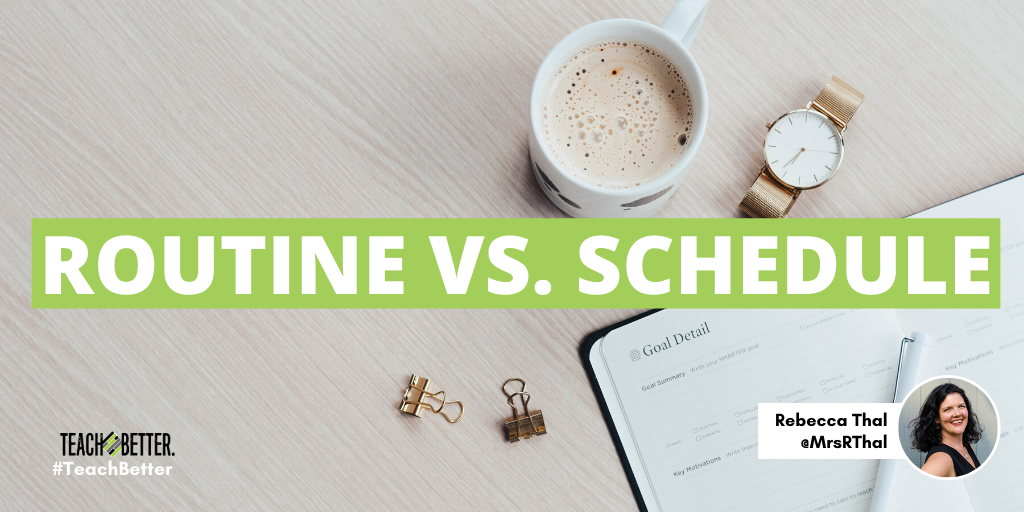TL;DR:
- Establishing a flexible routine for children includes your morning routine, work routine, downtime routine, and evening routine.
- Kids can either follow a strict schedule or a daily routine.
- It’s important to remember that life happens—circumstances and emotions change day to day.
Now that I am a few weeks into remote teaching with both my students and my own three kids, I have a few recommendations for all of you who are also juggling the teacher/parent role. A big one for me is the importance of establishing a routine.
Yes, routines are important for your students and yourself, but here I am going to focus on your own children. In my opinion, routines are more useful than schedules, but it certainly depends on your personality type and that of your kids.
Circumstances change, emotions change, kids don’t feel well one day, you don’t feel well the next - life happens (even in quarantine). Click To TweetWhat’s the difference between routine and schedule?
I should probably preface this by saying that I’ve personally never liked schedules. Maybe it’s because as a teacher we are tied to them all day, or maybe it’s because I associate schedules with having limited flexibility – and I like flexibility. Many people thrive on schedules, so you definitely have to do what works best for you. I simply feel that in this unknown, uncharted territory of remote teaching/learning, we need some flexibility. Things are changing by the week, day, and sometimes hour, and to be tied to a schedule seems unrealistic.
The other problem I have with schedules, now that we are several weeks in, is that mine and my own children’s work, plans, and online meetings continue to change and evolve on an almost weekly basis. This makes it very difficult to nail down a true schedule for everyone. But what I have realized is it’s very beneficial and necessary is to establish routines. It provides a general framework for how the days should play out, but offers you that much needed flexibility.
Below are some routines I’ve established that are working, for the most part, for my family. They are meant to serve as examples, as every family and situation is different, and may continue to change.
Establishing a Morning Routine
Each day I have my kids get up and get dressed, brush their teeth, and eat breakfast. I’m not a stickler about the wake up time since we all feel sleepier some days more than others, but it definitely needs to be within reason. I allow 8am at the latest for my 7th grader, and 9am at the latest for my 4th and 2nd graders. Psychologically I feel it’s important for kids and adults to get out of their pajamas every day, but this proves to be a challenge for everyone some days – especially teens.
Establishing a Work Session Routine
My kids make a list of all work (subjects) they have for the day, and I have them decide how to split it up between morning and afternoon sessions (this isn’t always an option). You can establish working hours, such as 9-11:30 for a morning session and 1:30 – 3:30 for an afternoon session. Assume there will be a snack break or two (or five!) within each session, so factor that into the times.
Within each session, kids should finish about half their work for the day. But again, it’s flexible, as some assignments may take longer than others. If need be, they can finish morning work in the afternoon, or save something until the following day.
Giving kids a space that is theirs to work is an important part of establishing a routine. This may not always be feasible, since kids may have to take turns on devices, or share space, but do the best you can with what you have to work with.
[scroll down to keep reading]Establishing a Playtime/Downtime Routine
My 7th grader would never allow me to call it “playtime” for him, so I’m including “downtime” as an option if you have older kids. It’s very important, especially for their emotional well-being, to have the kids take time for themselves. This can be built into lunchtime and/or once afternoon work is done.
My younger son, who generally gets up early, likes to play before school work starts, too. One thing I realized (the hard way) is that it’s not a good idea to let electronics be part of playtime/downtime during the day. I reserve video games for the evening, once I’m confident everything else is done to the best of their ability. On nice days, the kids go outside for at least 30 minutes. Downtime can also include doing video calls with friends and family to stay connected.
Establishing an Evening Routine
Once afternoon work is complete, I have my kids put away any learning materials they took out for that day, and plug in any devices that need to be charged. This helps keep everyone organized and my house looking a little less like a bomb went off! Again, there is playtime and dinner – and yes, electronic devices are permitted. The kids watch some tv and then get ready for bed (shower, brush teeth, pjs – you know the drill). We do some reading before bed to wind down, and I do my best to stick to their regular bedtimes.
This routine has probably been the hardest to follow thus far! I think the kids are just not getting as worn out as they normally would during a regular school day. We also don’t have sports practices and games to wear them out, so they are not as tired for bed. Several friends have expressed the same struggles. I’m hoping once the warmer weather hits, and they are outside even more, this will change.
Whether your kids follow a strict schedule or you establish routines for them, nothing is going to be perfect! There will be days where it all goes out the window, and that’s okay. Circumstances change, emotions change, kids don’t feel well one day, you don’t feel well the next – life happens (even in quarantine).
But what I have found is that offering some sort of structure to our children’s days is beneficial. It provides a sense of normalcy during this crazy time. It also helps them develop better organizational and time management skills. And once you’ve established routines for your kids, take time to establish routines for yourself, making sure to include self-care at some point in your day.
ABOUT BECKY THAL
Becky Thal is a 5th grade math and science teacher in New Jersey and a Data Analyst for the Teach Better Team. Prior to starting her career in teaching in 2005, Becky worked for several years in advertising in New York City. She is an active member of her school staff, currently serving on several committees including SEL, Climate and Culture, and the Future Ready Team. Becky is also an active member of her community and her children’s schools. In her spare time, she enjoys trips to the beach, trying new restaurants, and attending her kids’ various games and events . Becky lives with her husband, three children and dog, Cliff, who she loves spending time with on the weekends.




